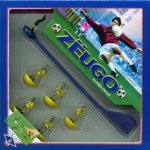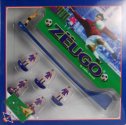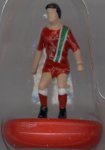
| Peter Upton's |
Subbuteo Tribute Website. |
|
The Team Colours Project. |
|
Appendix : Zëugo Teams 1-54 |
When Hasbro stopped supplying Subbuteo teams to Italy in 1996-97, Italian distributors Edilio Parodi responded by producing a clone of the game for their home market. I believe that this was originally going to be called "Play by Play", but eventually it ended up being called Zëugo.
The player figure used in Zëugo is clearly a second generation casting of the old heavyweight Subbuteo player of the 1970s. In looks they are slightly fatter and certainly less detailed than the Subbuteo version. The thick paint used on the teams may also contribute to the lack of detail. It isn't really a problem however, and it actually makes the players more robust. The normal breaking points of ankles and necks are a good deal thicker, so you can let your kids give these a good pounding !! If there is a downside, it is the slight feeling that this extra weight on the players makes them more top-heavy, and therefore more prone to falling over. The goalkeeper is also the sturdy upright 1970s version, which was always one of my preferred 'keepers, and it is a great shot stopper. In Zëugo he comes on a blue rod which is a couple of centimetres longer than the Subbuteo version. In another throw back to the classic era, the teams are hand painted.

With Zëugo, Parodi sensibly follows the Subbuteo approach to teams; that a good team range creates repeat sales which strengthen the game. It seems obvious, but it is amazing how many football games miss this trick. Individual Zëugo teams are produced in large and attractive display boxes.
The original range was fifty two teams, which was then enlarged to fifty six. (At this point the French national side was also updated.) Being an Italian game, the list is dominated by Serie A, with the first fifty two teams consisting of 24 Italian clubs, 19 top European sides, and 9 national sides. As the kits are hand painted they are not fully detailed. There are no chest adverts here. In addition some of the kits are now a little out of date, and the selection of British sides is not only quirky but inaccurate in places. The original Aston Villa (now called a 2nd) is very odd, and Coventry City don't look quite right either. But this rather adds to the charm.
I've listed the club names as released, but the boxes only have numbers on them. An advantage of the generic nature of these kits is that the teams can easily be used as other sides. For example, English Zëugo fans can use ref 1 as Newcastle, ref 27 as Sunderland, and ref 13 as Man City among others.
Team Colours.
(Italian clubs unless otherwise stated).





 The second
version of France.
The second
version of France.

 The second
version of France 2nd.
The second
version of France 2nd.
Zëugo production was halted during the period that Parodi held a Subbuteo licence (2002-03), and these teams sold out during that period.
Zëugo Production 2004 onwards.

Once Parodi's Subbuteo licence had finished, the Zëugo game was re-launched. Instead of reproducing the old (and therefore out-of-date) range of teams, Edilio Parodi launched a new team range. This range initially consisted of forty-four teams, all top sides/kits taken from their Subbuteo range. None of these kits were updated initially, so although more recent than the Zëugo team range they were replacing, most were still technically out-of-date. The teams were listed in alphabetical order, on numbers 1-44, so there was no connection to the previous range at all.
For those interested, this was the original "display box" range from 2004.
|
|
|
|


The following year, the teams switched to a new box, and a new base supplier - Profi-base. Initially, these new boxes saw the re-release of the original 44 sides, and the addition of another three teams, bringing the range to 47.
The next number (ref 48) was a replacement England kit, and a sign of things to come. The range seems to have adopted the Subbuteo method of giving new numbers to replacement kits, so there are now Barcelona kits on numbers 004, 093 and 140. That said, there seems to be more than one Croatia on reference 14, and also a couple of Palermo outfits on reference 32. The first big expansion was a 2006-07 Premiership range, which coincided with the new box set being sold in the UK. The Premiership teams not previously produced were given numbers between 52 and 67.
The number of teams sold/available has continued to grow, albeit not at the rate that Soccer 3D has expanded. As of 2010, Parodi has produced a new Zëugo poster, showing the teams currently available. The team numbers on this chart reached 161, with 112 available. The majority of the teams do seem to be Premiership ones, with new arrivals, and new kits covered. There are extra Italian teams (of course), with new Serie B arrivals like Sassuolo and Grosseto checked. There are top European teams, a scattering of national sides, and a range of Belgian teams, probably because they still have a large table soccer community in Belgium. The most recent addition to the range is another big expansion, covering all the 2010 World Cup qualifiers not currently produced. This increased the range from 161 to 180.
Even that is not the whole story. When UK table soccer shop Subbuteoworld switched from supporting Soccer 3D to Zëugo, he introduced a large number of teams on a completely different numbering system to that seen elsewhere. Many of these teams are still available on his website, with no numbers now attached to them.
Like Parodi's Subbuteo, and Astrobase's Soccer 3D, I find myself in a position where I cannot currently dedicate a huge space on the website to a large modern range.
April 2022:- Okay, I didn't have time or space to dedicate to this task, but luckily for us all, Colin Forward has filled this particular need. The appropriately named The Zeugo Catalogue illustrates the full range. If you consider that by 2022 the Zeugo range has expanded to over 400 teams, this is a really impressive undertaking.
[ Main Page | Previous Page ]